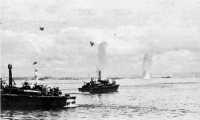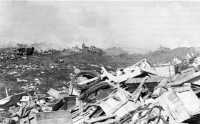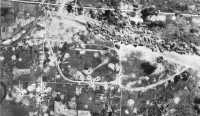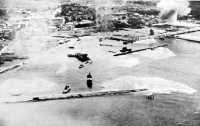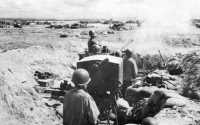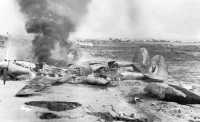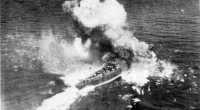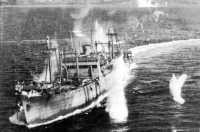Chapter 6: The Japanese Reaction
The Japanese undertook the defense of Leyte with serene assurance. Their pilots had erroneously reported the naval battle off Formosa as a great victory and declared that only remnants of the once strong American Navy remained. The defeatist attitude of the summer of 1944 vanished.
During the summer there had been disagreement among the Japanese military leaders. Imperial General Headquarters felt that the decisive battle should be fought on Luzon and only delaying actions taken in other areas. To this the 14th Area Army agreed. The Southern Army, on the other hand, believed that it would be impossible to wage a successful battle on Luzon if other areas, especially the Visayan Islands, were allowed to fall into American hands. Since these islands, if captured, could be used as Allied air bases, the decisive battle should be fought whenever and wherever the Americans attacked.1
Confident that the U.S. fleet had suffered grievously in the battle off Formosa, the Japanese closed ranks and all the commands agreed that the time was most opportune to deliver the coup de grâce. The foolhardy Americans would take a severe drubbing, and Japan, after a long series of humiliating and costly defeats, would regain the initiative. It was therefore a jubilant Imperial General Headquarters that ordered its armed forces to do battle with the Americans.
The essence of the Imperial General Headquarters plan was simple. The American convoys and carriers were to be given complete freedom in their journey to the Philippine Islands. When they were sufficiently close to make retreat difficult, the main strength of the Japanese Army, Navy, and Air Forces would descend upon them and deliver a knockout blow. If the operation were launched too early, the Americans could annihilate the inferior Japanese air strength before the battle could be fought; if too late, the Americans could escape and the objective would be lost. Imperial General Headquarters, therefore, was “patiently waiting” for the opportune moment.2
The Air Forces
On the evening of 17 October the 4th Air Army, upon receiving word that the U.S. forces were in the vicinity of Suluan Island, ordered the entire 2nd Air Division to attack the Americans. The main strength of the fighter units was to be concentrated in the central and southern Philippines areas. Although bad weather prevented a reconnaissance, the increase in American air raids on the central and southern Philippines made it imperative for the Japanese to
attack with their main air force. The 2nd Air Division was ordered to move from Clark Field on Luzon to Bacolod on Negros Island. It was unable to do this because of the bad weather, and it was therefore unable to forestall the American landings. The commander of the 4th Air Army decided on 21 October, as a result of the American landings, to use the entire air force under his command, employing the 7th Air Division and the 30th Fighter Group, in addition to the 2nd Air Division. The 12th Air Brigade of the 30th Fighter Group had just arrived in the Philippines from Japan, via Shanghai, and it was necessary to employ this brigade immediately because of the impending battle in Leyte Gulf.
All the various units were to launch an attack against the American land forces and shipping by the evening of 23 October. On 24 October there was to be a series of aerial attacks, the first early in the morning with the entire force; the second consisting of two waves; the third by the entire force in the evening; and during the night by waves of heavy and light bombers and assault planes.3
The Americans anticipated increased aerial activity over Leyte, and therefore the number of fighters was increased on 24 October to 36, on call from 0545 till dark, with an additional 16 fighters ready for immediate action upon request. Twenty-eight of the 36 were assigned to the attack force commanders and 8, retained by General Krueger, patrolled the beachhead area and provided additional fighters when and where they were needed.
The Leyte area was subjected to a heavy air assault on the same day, 24 October, when an estimated 150 to 200 enemy planes (mostly twin-engined bombers) approached northern Leyte. Sixty-six were definitely shot down and eighteen others were probably shot down.4 On the American side, forty combat air patrol and ten direct supporting planes participated in this engagement. Three American aircraft crash-landed – two on the Tacloban airstrip and one in the water.5 Only a small percentage of the American air activity was directed toward the neutralization of the enemy air force, as most of the available aircraft were attacking the Japanese fleet. The Japanese were determined to “make Leyte the decisive air battlefield as well as the decisive ground and naval battlefield of the Philippines.”6 For the first time since the Allied counteroffensive in the Pacific had started rolling, the Japanese, for an extended period, risked aircraft in great numbers in daylight raids as well as at night. The shipping off Tacloban and Dulag and the Tacloban airfield were the principal targets, though other air installations on the island were hit. An example of the enemy’s dogged determination occurred during the evening and night of 27 October. At twilight, twelve enemy fighters and dive bombers dropped 100-pound bombs in the vicinity of Tacloban and tried repeatedly but unsuccessfully to strafe the Tacloban airstrip. After a lull, the Japanese aircraft renewed the aerial assault just before midnight and continued almost uninterruptedly until dawn. Between 2332 and 0125, there were nine raids of two to four planes each; between 0340 and 0450, three raids of two to four planes each; and between 0454 and 0555 five additional planes made an attack on the area.7 The
Japanese air attacks on shipping (above) and supply dumps (below) were a constant threat during the early days of the invasion
Tacloban airstrip frequently was “well illuminated” by burning aircraft.8
The 2nd Air Division assaulted American shipping from 24 through 28 October, but because of the increasing necessity for giving air cover to the convoys the main strength of fighters of the 4th Air Army was used to protect the transportation of reinforcements of the 14th Area Army of Leyte. From 25 October on, the Bacolod airfield and the air forces protecting the Japanese convoys going to Leyte were attacked by American bombers and suffered serious losses. Since it had to participate in every phase of the action, the losses of the 4th Air Army were heavy.9
After 1 November the Japanese increasingly felt the American air power through attacks upon their air bases and shipping. Their fighter units, which had suffered considerable losses in protecting the convoys, were ordered to counterattack. They were not successful. At the same time the 4th Air Army received orders to protect the reinforcement convoys in the Manila area. By this time the Japanese air forces’ wings had been clipped and “what had once been a formidable weapon was transformed into a sacrificial army of guided missiles.”10 The suicidal kamikaze pilot became the sole hope of the Japanese air forces.
The Battle of Leyte Gulf
Japanese Naval Plans
On 21 July the chief of the naval general staff, Imperial General Headquarters, issued a directive for subsequent “urgent operations.”11 The operational policy to be followed by the Combined Fleet was as follows:
1 Make utmost effort to maintain and make advantageous use of the strategic status quo; plan to smash the enemy’s strength; take the initiative in creating favorable tactical opportunities, or seize the opportunity as it presents itself to crush the enemy fleet and attacking forces.
2. Co-operate in close conjunction with the Army, maintain the security of sectors vital to national defense, and prepare for future eventualities.
3. Co-operate closely with related forces to maintain security of surface routes between Japan and vital southern sources of materials.12
On 26 July the chief of the naval general staff informed Admiral Toyoda, Commander in Chief, Combined Fleet, that the future “urgent operations” were to be known as the SHÕ (Victory) Operations. There would be four SHÕ Operations. The first was to cover the defense of the Philippine Archipelago.13 It was essentially the last chance for Japan to remain in the war. Said Admiral Toyoda of the situation at the time of the battle of Leyte Gulf:
Since without the participation of our Combined Fleet there was no possibility of the land-based forces in the Philippines having any chance against your forces at all, it was decided to send the whole fleet, taking the gamble. If things went well, we might obtain unexpectedly good results; but if the worst should happen, there was a chance that we would lose the entire fleet. But I felt that that chance had to be taken. ... Should we lose in the Philippines operations, even though the fleet should be left, the shipping lane to the south would be completely cut off, so that the fleet, if it should come back to Japanese waters, could not obtain its fuel
supply. If it should remain in southern waters, it could not receive supplies of ammunition and arms. There would be no sense in saving the fleet at the expense of the Philippines.14
Since their carrier force was weak, the Japanese had developed a plan based upon the main gunnery strength of the fleet and upon the land-based air forces. Battleships and cruisers from a southern base were to approach Leyte from the south, fight their way to the landing beaches, and destroy Allied assault shipping. A decoy force was to attempt to lure the U.S. carrier task force away from the main action. Shore-based air forces were to inflict maximum damage on the American carrier forces whenever and wherever possible, but once the invasion came they were to conserve their strength until the day of the landings, when all the Allied assault shipping would be concentrated off the beaches and when their attacks on the U.S. carriers would assist the advancing Japanese fleet. The plan was designed to get the Japanese naval gunnery force into a position where it could do the greatest damage. Little attention was paid to getting it out. “The war had reached a point where the Japanese fleet, hopelessly outnumbered and, as imminent events would prove, even more hopelessly outclassed, could not risk the fleet action it had previously desired but was forced to expend itself in suicidal attack upon the United States transports.”15
Upon receiving information on 17 October that American vessels were off the shores of Suluan Island, Admiral Toyoda immediately alerted his forces. On 18 October Toyoda, after intercepting American messages dealing with the landings on the island approaches to Leyte Gulf, activated his plan for the defense of the Philippine Islands. The target date (X Day) for the fleet engagement was set for 22 October but logistical difficulties caused a series of delays and on 21 October Admiral Toyoda changed X Day to 25 October. “From the far corners of the shrinking Empire the whole combatant strength of the Japanese Navy converged on Leyte Gulf.”16
The Naval Battle
The strongest Japanese naval force 17 – the 1st Diversion Attack Force--moved from the south, reached Brunei Bay in northwest Borneo on 20 October, and after refueling split into two parts and proceeded on its way two days later. The main strength of the 1st Diversion Attack Force, under Admiral Kurita, sailed northeast up the west coast of Palawan (one of the Visayan Islands), and then turned eastward through the waters of the central Philippines to San Bernardino Strait, while the smaller unit commanded by Vice Adm. Shoji Nishimura moved eastward through the Sulu Sea in order to force an entrance at Surigao Strait. The 2nd Diversion Attack Force, commanded by Vice Adm. Kiyohide Shima, after leaving the Pescadores on 21 October,
sailed south, past western Luzon, and after refueling in the Calamian Islands, just south of Mindoro, proceeded to follow and support the southern part of the 1st Diversion Attack Force in forcing Surigao Strait.
The Main Body, consisting chiefly of partially empty carriers with a destroyer escort, departed on the 20th, and on the evening of the 22nd turned southwest toward Luzon. It was commanded by Vice Adm. Jisabuto Ozawa. The Main Body was to act as a decoy to draw off the main American strength. The Japanese submarines off Formosa were ordered south toward the eastern approaches to the Philippine Archipelago and the 2nd Air Fleet, shortly before 23 October, began to arrive on Luzon.18
There were two American fleets in Philippine waters – the Seventh Fleet under Admiral Kinkaid, whose superior was General MacArthur, and the Third Fleet under Admiral Halsey, whose superior was Admiral Nimitz. The Seventh Fleet, which consisted of 6 old battleships, 16 escort carriers, 4 heavy cruisers, 4 light cruisers, 30 destroyers, and 10 destroyer escorts, had escorted the convoy to Leyte and now stood by to protect it as it unloaded. The Third Fleet was composed of Task Force 38 under Admiral Mitscher. It consisted of four task groups which averaged 23 ships each, divided about as follows: 2 large carriers, 2 light carriers, 2 new battleships, 3 cruisers, and 14 destroyers. The task force was to secure air supremacy over the Philippines, protect the landings, and apply unremitting pressure on Japan. If the opportunity to destroy the major portion of the Japanese fleet should arise or could be created, that destruction was to be its primary task.
The Japanese had 4 carriers, 7 battleships, 19 cruisers, 33 destroyers, and 2 battleship- carriers which carried no aircraft; there were 108 planes on the carriers and about 335 shore-based planes in the Luzon area.19
On 23 October two American submarines, the Dace and the Darter, encountered the 1st Diversion Attack Force and sank two heavy cruisers, the Atago and Maya, off the western coast of Palawan. The former was Kurita’s flagship; its sinking forced the Japanese admiral to transfer hurriedly to another vessel. The submarines also seriously damaged another heavy cruiser.
Upon receiving information that the Combined Fleet was steaming toward the Philippines, Admiral Oldendorf’s fire support group of the Seventh Fleet moved to the southern end of Leyte Gulf and formed a battle line across the mouth of Surigao Strait while motor torpedo boats patrolled within the strait and about its southern entrance. Halsey’s Third Fleet moved toward San Bernardino Strait. The escort carriers from Kinkaid’s Seventh Fleet cruised off Leyte Gulf.20
On the 24th, after receiving a report from the submarine, the carriers of the Third Fleet sent aircraft to search to the west and southwest. These aircraft sighted the main part of the 1st Diversion Attack Force south of Mindoro, and sighted and attacked the smaller force under Admiral Nishimura off Negros, slightly damaging a battleship and a destroyer. The aircraft of the carriers from their position off San Bernardino Strait struck repeatedly at Kurita’s force while the smaller Nishimura force was left to the battleships in the gulf. One Japanese battleship
of the 1st Diversion Attack Force was sunk, one heavy cruiser rendered impotent, and minor damage was inflicted on other battleships. The Japanese were forced temporarily “to reverse course to westward.”21
The aircraft from the Japanese 2nd Air Fleet attempted to aid the naval forces which were moving eastward through the Philippines. In co-operation with some aircraft from the Main Body, which was now about 100 miles east of Luzon, they attacked the northernmost unit of the American carriers. Halsey’s airmen sighted and reported the sacrificial Japanese Main Body in the afternoon. Not knowing that this force consisted mainly of empty carriers and believing that the 1st Diversion Attack Force had been severely damaged, Admiral Halsey withdrew the battleships and carriers of his Third Fleet and steamed north to meet the new threat, leaving San Bernardino Strait wide open. At midnight Kurita’s 1st Diversion Attack Force moved unmolested through San Bernardino Strait and turned south toward Leyte Gulf. The Japanese strategy had worked.
In the early morning hours, Admiral Oldendorf’s warships destroyed the Nishimura force as it sailed into Surigao Strait. Of two battleships, one heavy cruiser, and four destroyers, only the cruiser and one destroyer escaped from the strait, and the cruiser, which had been damaged, was sunk by aircraft from the U.S. carriers the next morning.22 Admiral Shima’s 2nd Diversion Attack Force, entering the same strait thirty minutes after Nishimura’s force, suffered damage to a light cruiser that was hit by American torpedo boats. Shima’s force then made an abortive attack, during which its flagship was damaged by collision, and withdrew without having engaged. The Third Fleet far to the north fell upon the decoy forces, sank all four carriers of the Main Body, and thus “wrote an end to the Japanese carrier air force.”23
Admiral Kurita’s 1st Diversion Attack Force “for which so much had been sacrificed”24 encountered Kinkaid’s carriers and destroyers off the coast of Samar. Admiral Kinkaid was ill prepared to meet the main thrust of the Japanese Navy, since his carriers were protected only by destroyers and destroyer escorts. His “handling of the exceedingly difficult situation” was “superb.”25 The aircraft from his carriers under Rear Adm. Clifton A. F. Sprague rose to the occasion and gave a “magnificent performance,”26 continually attacking the much stronger 1st Diversion Attack Force. Kurita’s forces sank one carrier, two destroyers, and one destroyer escort but lost three heavy cruisers and had one crippled. The American fighting strength was greatly diminished at the very time it was needed to protect the amphibious shipping that had carried the Sixth Army, and which still lay near the shores of Leyte Gulf. Just as it appeared inevitable that Kurita would move in and deliver the coup de grâce, he suddenly broke off the engagement and retired toward San Bernardino Strait. After the war he stated in justification of this strange move: “The conclusion from our [the Japanese] gunfire and antiaircraft fire during the day had led me to believe in my uselessness, my ineffectual position, if I proceeded into Leyte Gulf where I would come under
even heavier aircraft attack. I therefore concluded to go north and join Admiral Ozawa for coordinated action against your northern Task Forces.”27
Said Admiral Sprague: “The failure of the enemy main body and encircling light forces to completely wipe out all vessels of this Task Unit can be attributed to our successful smoke screen, our torpedo counterattack, continuous harassment of enemy by bomb, torpedo, and strafing air attacks, timely maneuvers, and the definite partiality of Almighty God.”28
The battle for Leyte Gulf was over. It had ended in a resounding victory for the Americans, whose losses of 1 light carrier, 2 escort carriers, 2 destroyers, and 1 destroyer escort were small in comparison with the Japanese losses of 3 battleships, 1 large carrier, 3 light carriers, 6 heavy cruisers, 4 light cruisers, and 9 destroyers.29
As the Japanese retreated throughout the 25th and 26th of October, carrier- and land-based aircraft struck at the enemy vessels and inflicted fresh injuries upon them. The Sixth Army summarized its view of the probable consequences if the battle had gone against the U.S. Navy as follows:–
Had the [Japanese] plan succeeded the effect on the Allied troops on Leyte in all likelihood would have been calamitous, for these troops would have been isolated and their situation would have been precarious indeed. If it had been victorious in the naval battle, the Japanese fleet could have leisurely and effectively carried out the destruction of shipping, aircraft, and supplies that were so vital to Allied operations on Leyte. An enemy naval victory would have had an adverse effect of incalculable proportions not only upon the Leyte Operation, but upon the overall plan for the liberation of the Philippines as well.30
The Sixth Army, however, was depicting the worst of all possible contingencies. Admiral Halsey’s conclusion is quite different:–
That Kurita’s force could have leisurely and effectively carried out the destruction of shipping, aircraft, and supplies in Leyte Gulf was not in the realm of possibilities. ... Kurita would have been limited to a hit-and-run attack in the restricted waters of Leyte Gulf. He would further have been subjected to the attack of the cruisers present in Leyte Gulf. He would have been limited to minor damage. ... The statement that an enemy naval victory would have an effect of incalculable proportions not only on the Leyte operation, but upon the overall plan for the liberation of the Philippines as well, can only be premised on the thought that our naval forces would be almost totally destroyed. The prognostication of such a condition could be reasoned on none of the facts existing during this three days’ engagement.31
The Japanese Reinforce the Leyte Garrison
The Japanese felt that the honors of the battle were evenly divided and consequently continued with their program of making Leyte the decisive battle of the Philippines. Although the American fleet had soundly whipped the Japanese Navy, the Japanese were still able to send reinforcements in great numbers to their Leyte garrison. Because of the lack of sufficient aerial strength, the Americans were unable to check the steady flow of troops into the port of Ormoc.
American Aerial Retaliation
The carrier strikes of the Seventh and Third Fleets up to and through A Day had been most successful in forestalling any concentrated effort on the part of the Japanese against the American shipping in Leyte Gulf and the troops on the coastal strand. Thereafter, the Japanese unleashed a furious air assault on the American forces and shipping.32
At the same time, American aircraft from the carriers struck at the Japanese troops and their installations in close support of the ground troops. The first called-for air strike was at 0834 on 21 October against bridges over streams that were not fordable along the road leading from Ormoc to Carigara, in order to prevent enemy movement along this road.33 A total of 121 missions were flown in support of ground units during the first four days, of which only 33 had been requested by the air liaison parties. The targets for these missions included artillery and mortar positions, fuel and supply dumps, bridges, pillboxes, and other installations, together with trucks, armored vehicles, and tanks.34
During the initial stages of the campaign, Navy flyers gave efficient close support to the ground forces.35 The average time required to carry out each of these support missions was approximately one hour, though the usual difficulties of locating friendly troops and pinpointing the target were present. Enthusiastic reports on the effectiveness of this co-operation from naval air were made by the 7th Division. Members of this division, which formerly had been supported by Army and Navy air forces, found Navy air support in the first days on Leyte far more satisfactory than that which the Army Air Forces had been able to provide in the past. They believed that this superiority was due to the system that the Navy had worked out for directing strikes at close-in targets without endangering friendly ground forces, and to the Navy’s use of rehearsals with ground units to establish mutual understanding and confidence.36
The Battle of Leyte Gulf interfered greatly with the close support rendered by the Navy, since the carrier-based planes had to be withdrawn. The combat air patrol assignments were also disrupted because of surface engagements and the repairing of the CVEs.37
At this time the Japanese had about 432,000 men in the Philippines, including air force and construction units. Most of them believed that they were well prepared to meet the Americans. In fact a staff officer of the 14th Area Army, upon hearing that the Americans had landed on Leyte, is reported to have jumped up and exclaimed: “Good, they have picked the place where our finest troops are located.”38 It was also thought that the American troops on Leyte were “having a difficult time.”39 Nevertheless, General Yamashita, who had succeeded
Kuroda as the commanding general of the 14th Area Army, sent the 1st Division and other units to Leyte. The Japanese felt that “if the decisive battle in Leyte results in failure, it will upset the entire operation in the Philippines and the decisive battle in Luzon will be lost.”40
By the 25th of October a battalion of the 55th Independent Mixed Brigade and one of the 57th Independent Mixed Brigade from Cebu, together with two battalions of the 30th Division, had arrived on Leyte to reinforce the 16th Division. Shortly after the Sixth Army landed, the 35th Army commander, General Suzuki, received orders from General Yamashita to undertake an all-out offensive against the Americans. All Japanese air, naval, and land forces were to participate.41
On 22 October the 14th Area Army asked the 55th Army how the 26th Division and 68th Independent Mixed Brigade were to be utilized if the Japanese decisively won the pending naval battle. The 35th Army stated that if the Japanese Navy were victorious, the units were to prevent the landing of more Americans at Leyte Gulf, but if it were unsuccessful the troops were to be landed at Carigara Bay. The optimism of the Japanese was high. Said Maj. Gen. Yoshiharu Tomochika, Chief of Staff, 35th Army: “We were determined to take offensive after offensive and clean up American forces on Leyte Island. ... We seriously discussed demanding the surrender of the entire American Army after seizing General MacArthur.”42 Then came the Battle of Leyte Gulf.
Despite the setbacks caused by this disastrous sea battle, the Japanese continued to send troops to Leyte through Ormoc. The reinforcement of Leyte consisted of moving five major units, in nine echelons: the 35th Army moved as many of its units as possible from Mindanao, Cebu, and Panay; the 1st Division was sent down from Luzon on 1 November; then the 26th Division, the 68th Independent Mixed Brigade, and one third of the 8th Division were sent from Luzon in the order given.43
On 27 October the Fifth Air Force took over the mission of supporting the Sixth Army. As the airstrips were not in serviceable condition, only a small detachment – the 308th Bombardment Wing – could be sent in. Aircraft from the carriers continued to give support. The Fifth Air Force felt that it could best check the Japanese reinforcement program, and at the same time give more lasting support to the ground troops, by attacking the Japanese convoys before they arrived in Leyte. The Fifth Air Force intended also to attack large movements of land troops, concentrations, and supply areas. Army Air Forces doctrine assigned close support as the third priority mission of tactical air forces.44 Since there were always insufficient aircraft for the missions assigned to the air forces, close support of ground troops suffered.
The Allied Air Forces, which had been given the mission of supporting the Leyte operation, directed its main efforts against airfields in bypassed areas. Two fighter groups were on Morotai, one heavy bomber group was on Noemfoor, off the north coast of New Guinea, and two heavy bomber
Air strikes against Japanese installations included attacks on Bacolod Airfield, Negros Island
Attack on shipping in Zamboanga harbor, Mindanao
groups were on Biak; they completed 175 sorties in strikes against airfields on Mindanao and the Visayan area. The main targets of attack were on Mindanao and Cebu and in the Negros area.45 The XIII Bomber Command, which carried the burden of this assault, was to neutralize targets previously hit and protect the southwestern flank of the American forces in the Philippines. The 42nd Bombardment Group (medium bombers) in October flew the greatest number of sorties in the history of the group up to that time.46
The heavy bombers (B-24’s) of the 868th Bombardment Squadron, operating from Noemfoor, had as their main target enemy shipping in the Makassar Strait. At the same time, the B-24’s that were within range of the Sulu Sea struck at the Japanese Southern Fleet as it retreated after its engagement with the Seventh Fleet. The fighters and medium bombers, which had been used to strike at targets on Mindanao, were alerted to strike any enemy naval vessels that came within range.47
While protecting the southwestern flank of the American forces in the Philippines, the XIII Bomber Command was extraordinarily busy on 26 October. Part of the Japanese naval task force, consisting of three battleships, five cruisers, and four destroyers, had withdrawn from the Leyte area and was in the Sulu Sea when sighted by the 307th Bombardment Group. Twenty-eight B-24’s of the bombardment group made their principal targets two of the battleships – one of the Kongo class and the other of the Yamato class. Three of the planes were shot down as the Japanese skillfully and evasively maneuvered their vessels so that none was sunk. At the same time B-24’s from the 5th Bombardment Squadron sighted and sank an enemy light cruiser at a different location in the Sulu Sea.48
General MacArthur had originally allocated the attack of all land targets in the Philippines to the Allied Air Forces,49 and although subsequent events occasioned a modification of this order the Fifth Air Force officially established its advance units on Leyte at 1600 on 27 October and assumed operational control of land-based aircraft.50 The 308th Bombardment Wing, the advance echelon of the Fifth Air Force, had two major duties included in its mission. It was to obtain air superiority over the Philippines and to isolate the Japanese forces on the battlefield of Leyte. In addition to these two principal tasks it was to render maximum close support to the ground forces, establish night fighter patrols and a system of courier aircraft, and provide maximum protection to Allied naval vessels.51 Among the Army flyers of the 49th Fighter Group, an advance party of the Fifth Air Force that arrived on 27 October, was Maj. Richard I. Bong, of the 9th Fighter Squadron, the leading ace of the Army Air Forces. He celebrated his arrival by shooting down an enemy plane.52
Anti-aircraft gun in action at Tacloban airstrip, 27 October 1944
On 28 October the Army flyers of the 7th Fighter Squadron got their first enemy airplane on Leyte. Since there were “only” three enemy air raids during the night, the men were able to get some much needed sleep.53
The 29th of October, however, was a day of heavy action for the Army flyers, as described in a report of the 7th Fighter Squadron:
The 29th was a day that will be long remembered. ... Two more Nips were added to the unit’s score; ... the 49th Group’s 500th victory. But more important at that time was the fact ... [that] the ... road between the strip and the camp collapsed under army traffic. ... The already long hours were lengthened still more as pilots and men were forced to arise between three and four o’clock in the morning, make their way to the barge at Tacloban, cross to the strip by water and then sweat out the predawn raids. At night, the planes landing at dusk had hardly hit the runway before ... BOFORS [40-mm. antiaircraft guns] went off and the lights went out. Then down to the end of the strip near the gas dumps, and another session of sweating beneath A/A [antiaircraft] awaiting the barge for the trip back to Tacloban and then to camp. Supper was served as late as 10 o’clock ... a few brave individuals tried an alternate road to the south, swinging out east to WHITE Beach above Dulag and then north along the beach to Tacloban Strip. Japanese snipers soon put a stop to this travel during the hours of darkness.
To add to the “big day”--29 October – the weather observers reported a 50 knot gale on the way. Working after dark, pilots and linemen minus the regular tie downs and using tent ropes and anything available secured the airplanes to jeeps, trucks, trailers and tractors. At night, in camp, the small
Lockheed P-38 after Japanese raid on Tacloban airstrip
typhoon hit and with it went three or four tents, occupants of which awoke to find themselves thoroughly drenched and at odds with the world, Leyte in particular.54
Although 29 October was the most difficult day on Leyte for the men of the 7th Fighter Squadron, they were again disheartened the following day, when one of the squadron’s pilots was shot down by friendly antiaircraft.55
During the first week of November, offensive operations by the Fifth Air Force were primarily against targets in Ormoc Valley and enemy shipping in Ormoc Bay. The barrios of Ormoc, Valencia, and Palompon were the first land targets. Most of the strikes, however, were against Japanese shipping in Ormoc Bay and in the vicinity of the Camotes Islands.56
By 4 November a number of P-38’s had been destroyed by bombs and strafing, some of which were completely burned up. To cut down the aircraft losses, it was decided to have planes of some of the squadrons use the Bayug airstrip in the Dulag area. But since this was a poor airfield which soon became overcrowded and subject to Japanese air attacks, it was finally abandoned.57
On 3 November fifteen P-38’s of the 49th Bomber Group struck “one of the most lucrative strafing targets of their history.”58
In an early morning search for enemy shipping in Ormoc Bay the bombers found nothing, but on their return they sighted a ten-mile-long convoy of trucks, artillery, and tanks extending from Ormoc to Valencia. The convoy was strafed and dispersed, leaving twenty to thirty-five trucks destroyed and many other vehicles, including two tanks, in flames.59 However, two American planes were shot down by enemy antiaircraft fire, four came in on single engines, and all showed many bullet holes. The bombers made no further strikes against the convoy, “as all aircraft received extremely heavy and accurate ground fire.”60
The airmen of the Fifth Air Force continued to hit shipping in Ormoc Bay and in the Camotes Islands, and they also achieved success against bridges, airfields, troops, camp areas, and transportation.61 Although the number of Japanese air raids had diminished by 6 November, the Americans could not yet feel that they were “out of the rough.”62 There was insufficient direct air support for the ground troops throughout the operation and the Japanese continued to send troops into Ormoc. The constant stream of Japanese reinforcements coming into Leyte augured ill for the success of the operation.
The TA Operation
The TA Operation, by which name the Japanese program for the reinforcement of Leyte was known, continued from 23 October through 11 December. The numerical weakness of the U.S. land-based aircraft enabled the Japanese to land many thousands of troops and tons of supplies on Leyte. Nine convoys in all were sent to the port of Ormoc, on the west coast.63 As a whole, however, the operation was “literally gruesome” to the Japanese, since their transports and escort vessels were struck again and again by American aircraft.
The first Japanese convoy had three echelons. The first consisted of a landing barge and an auxiliary sailing vessel carrying about 300 troops of the 102nd Division. The second echelon, whose composition was identical with the first, carried about 150 troops of the same division. Both safely discharged their troops on 23 and 25 October, respectively. The third echelon was made up of 2 destroyers, together with 4 transports carrying about 2,000 men of the 30th Division. The transports safely unloaded their passengers on 26 October, but American airmen later sank the destroyers and all but one of the transports. The remaining vessel was damaged.
The second convoy consisted of three echelons, composed of 3, 1, and 4 transports respectively. The escorting vessels of the third echelon, the only one that had an escort, consisted of 6 destroyers and 4 coast defense vessels. The escort vessels carried the troops of the 1st Division: the first wave about 1,000 men, the second about 100 headquarters men, and the third approximately 10,000 troops and about 9,000 ship tons of provisions and ammunition. All vessels safely debarked their troops on 1 and 2 November.
The 5 transports of the third convoy carried about 2,000 troops of the 26th Division and approximately 6,600 tons of supplies.
Japanese convoy under attack in Ormoc Bay. A destroyer escort is blown apart by a direct hit
A large transport is straddled by bomb bursts
The convoy sailed from Manila on 9 November and was escorted by 1 submarine chaser, 1 torpedo boat squadron, and 4 destroyers. On 10 November, when the convoy reached the mouth of Ormoc Bay, American airmen destroyed all of the escort vessels and transports before they could unload their troops and cargo.
Each of the two echelons of the fourth convoy had 3 transports, but only the first one had an escort – 6 destroyers and 4 coast defense vessels. The first echelon carried approximately 10,000 troops of the 26th Division and about 3,500 tons of supplies, including provisions, ammunition, and four long-range guns. The second echelon carried about 1,000 men of the 1st Division. Both discharged their troops safely on 9 November, a day earlier than the anticipated arrival of the third convoy, but because of American air action, they were able to get only a limited part of the supplies ashore.
The fifth convoy was organized on the same pattern as its predecessor, but the first wave had a submarine chaser as an escort while the second had a destroyer. This convoy, which left Manila between 11 and 25 November with an unknown number of troops and quantity of supplies, was completely destroyed en route to Leyte.
The sixth convoy, composed of 2 transports, 2 submarine chasers, and 1 patrol boat, carried approximately 2,500 tons of provisions and ammunition. It entered Ormoc harbor on 28 November and had completed most of its unloading when the vessels were either sunk or set afire by U.S. aircraft and motor torpedo boats.
There were four echelons in the seventh convoy. The composition of the first two is unknown, but it is known that the first echelon completed unloading at Ipil just south of Ormoc on 30 November. The third and fourth echelons, consisting altogether of 3 transports and 2 destroyers, also carried an unknown number of troops and quantity of supplies. As they were unloading at Ormoc on 2 December, the vessels were attacked by American airmen who sank one of the destroyers and damaged the other. The transports and the damaged destroyer returned to Manila.
The 4 transports of the eighth convoy, escorted by 3 destroyers and 2 submarine chasers, carried about 4,000 troops – the main body of the 68th Independent Brigade--and an unknown quantity of provisions and ammunition. It unloaded some of its troops and a part of the cargo at San Isidro on the west coast of Leyte on 7 December; but immediately thereafter, American aircraft sank the transports and heavily damaged the destroyers.
There were two echelons in the ninth convoy. The first echelon, which consisted of 5 transports, 3 destroyers, and 2 submarine chasers, carried approximately 3,000 troops of the 5th Infantry Regiment, 8th Division, and about 900 tons of provisions and ammunition. In unloading at Ormoc on 11 December, 1 destroyer was sunk and 1 destroyer and 1 transport were damaged. The remaining vessels then moved to Port Palompon on the west coast of Leyte and completed unloading. The second echelon consisted of only one transport and carried an unknown number of troops and quantity of supplies. It was able on 11 December to elude the American airmen and complete its unloading.64
After the war, General Nishimura, who had been on the staff of the 14th Area Army, made the amazing statement that nearly 80 percent of the vessels sent to Ormoc were
sunk en route. Although most of the vessels went down close enough to the Leyte shore for the troops to swim ashore, the equipment lost could not be replaced.65 It is estimated that the Japanese landed more than 45,000 troops and something over 10,000 tons of matériel.66
Even though the Japanese had not succeeded completely in their reinforcement program, General Krueger was faced with a far stronger foe than had been anticipated. The Leyte Campaign was to be long and costly and was to upset the timetable for the impending Luzon operation. At the end of A Day the American assault forces had firmly established themselves on the shores of Leyte, but the battle for the island was yet to come.
